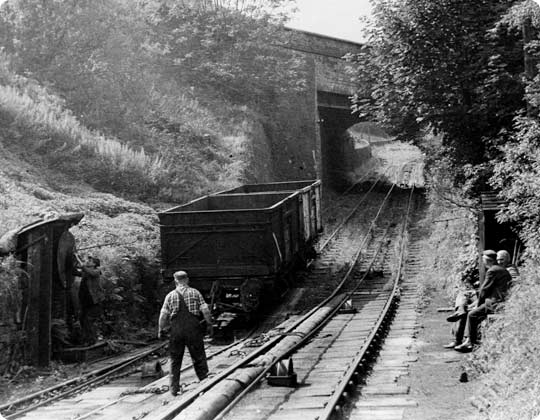
By the wagon position indicator. Someone is setting the indicator ready for the movement up the incline.
Compare the width of the over-bridge (below left) which has been streanthened for the increasing A6
traffic. Author Unknown.
HIGH PEAK RAILWAY WALKS
(Update: June 2017)
HIGH PEAK GOODS TO SHEEP PASTURE TOP

By the wagon position indicator. Someone is setting the indicator ready for the movement up the incline.
Compare the width of the over-bridge (below left) which has been streanthened for the increasing A6
traffic. Author Unknown.

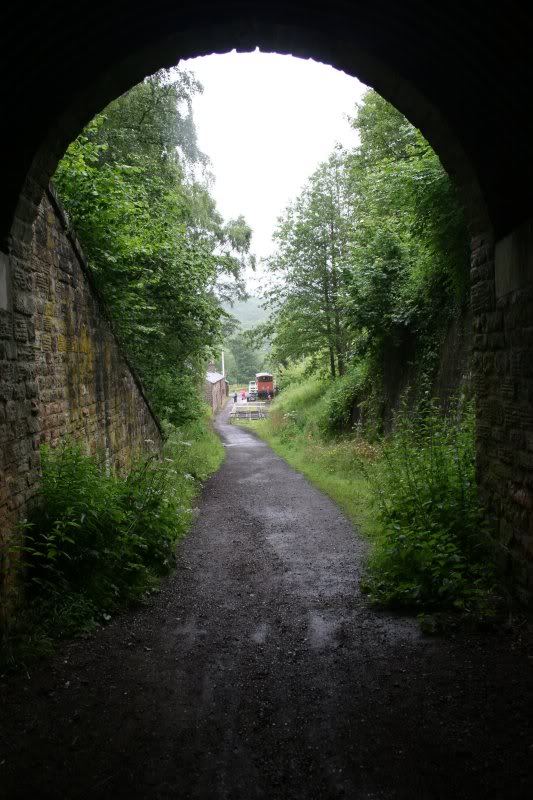
Left: The tunnel under the A6, looking up the incline. Right Looking down the incline From Inside the tunnel
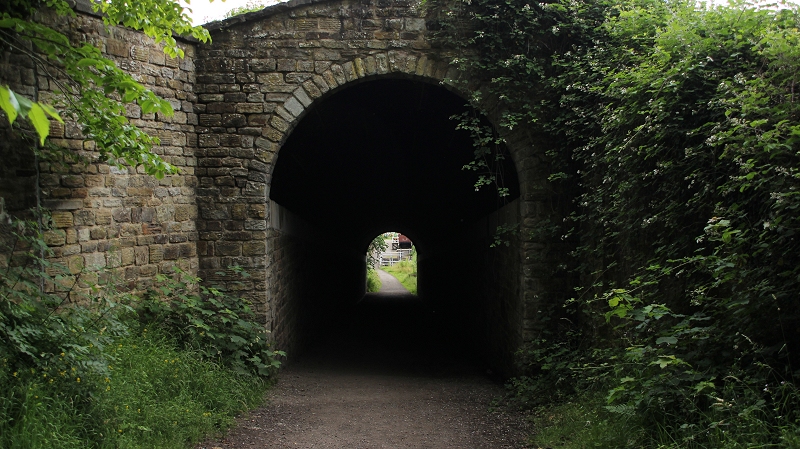
Notice how wide the bridge opening was in John Even's 1960's photo in comparison with the photo above where the bridge
was strengthened for the heavier traffic going over it on the A6..

The re-enforced bridge on the 24th June 2017.
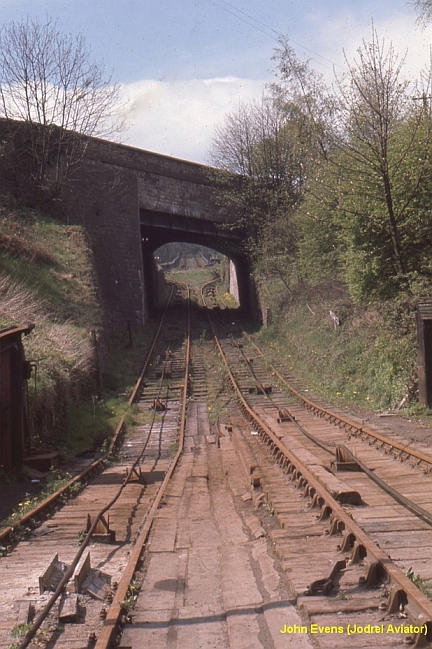
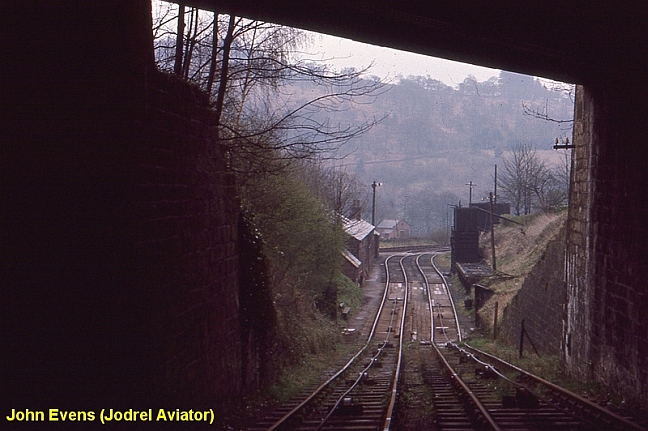
Same spot as above left. Right: Again, from the same spot as above right. The change to the over bridge is obvious.
(April 1967 photos by John Evens.)
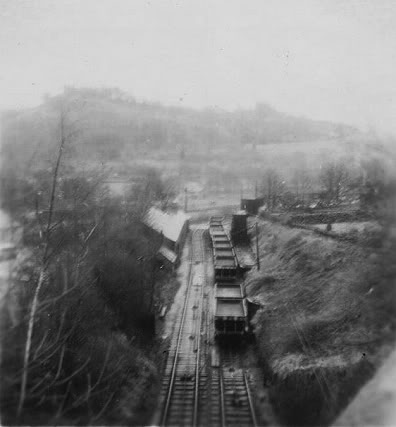
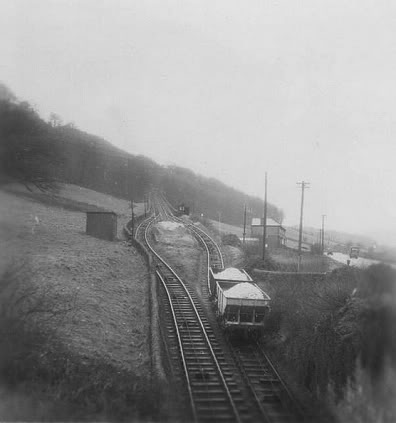
1960's photos from the A6 bridge, of wagons waiting to take the incline and of two loaded wagons descending past the catch pit. Up ahead is the
hut were the points man stood, ready to turn the points should a wagon runaway or a train gather too much speed down the incline.
(JodrelAviator (Flickr)).
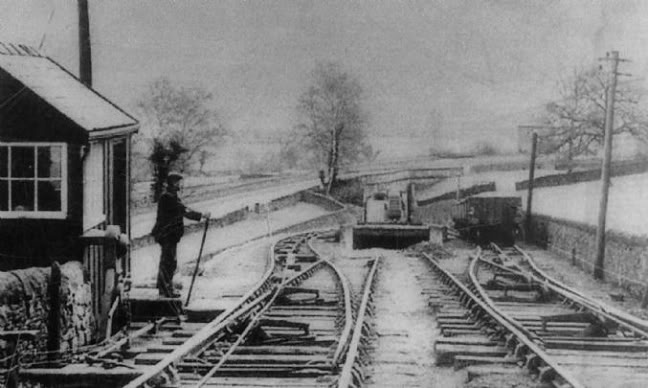

Points man standing by the trap point. Listening to the gong that sounded as the wagons came down the incline
and proving the rings remained constant he would close the trap points to the main running line. If the rings
became faster and faster the trap would be left open.
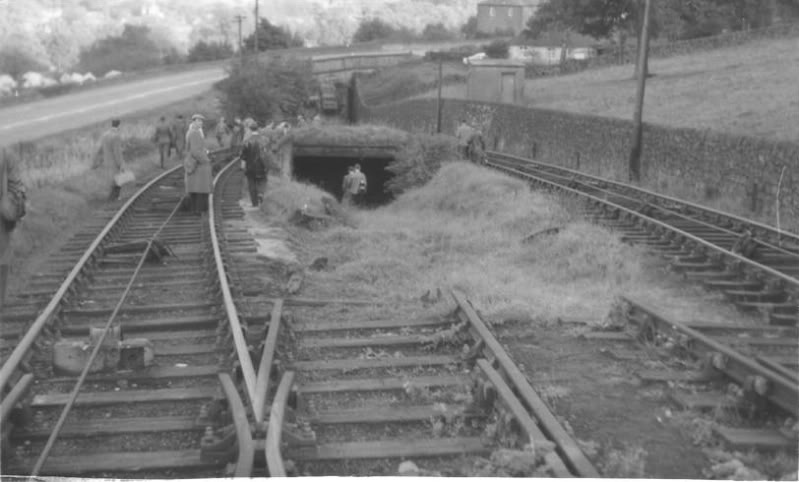
1961. photo. Another interesting point in regard to the roller guides is how each one is designed to guide the wire to the curvature of the track
formation. Interesting too that the main difference between this scene and the 2011 one above is that everything looks pretty muc the same
at this spot, except for the missing track and pulling wires. (J. D. Norton).
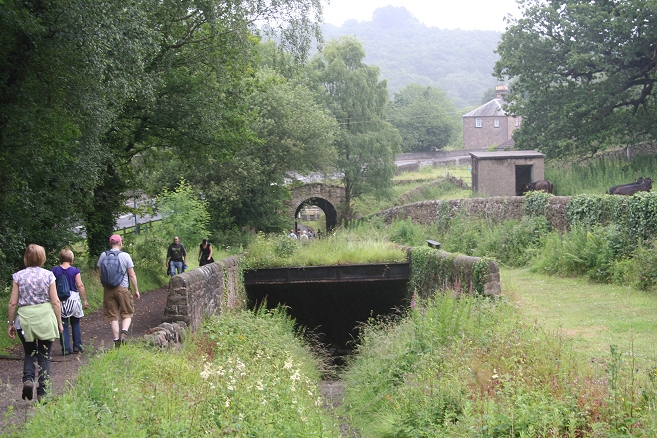
The catch pit was built after a wagon ran away and ended up in the canal. It has done it's job on a few occasions, the last being in 1946. The
The mangled wagon still lies where it came to a sudden stop. It is estimated that runaway wagons could reach 120 mph down the grade! The
two running lines ran around each side of the pit. As a point of interest! the bridge over the A6 has obviously been re-designed since the
railway closed as can be seen in the B&W photo above. where it is a simple road bridge. It has probably been strengthened to take
modern day traffic. There is not room for double track with the new bridge.
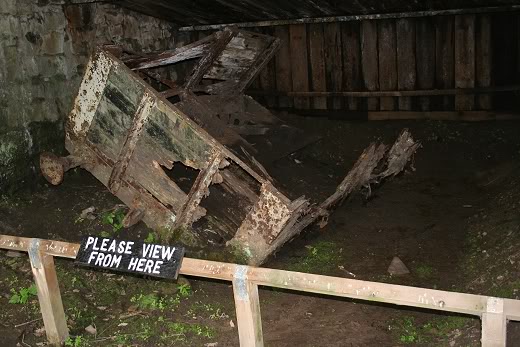
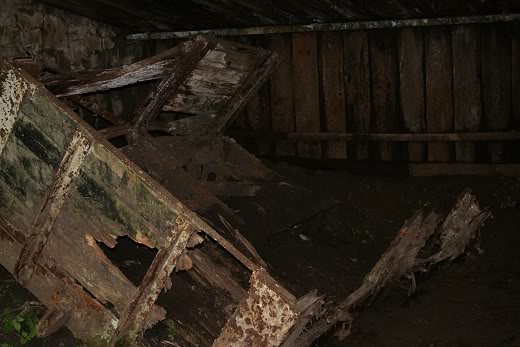
Remains of the 1946 runaway wagons. 65 years of decay.

The gradient gets steeper by one inch every nine inches

The opposite view looking down the gradient
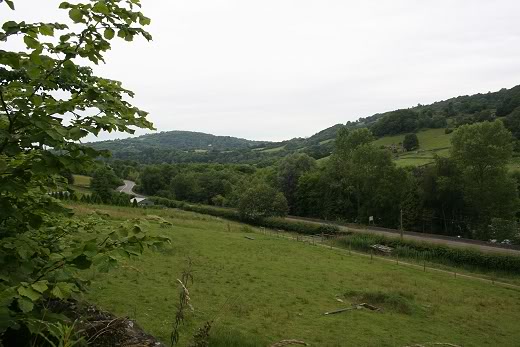
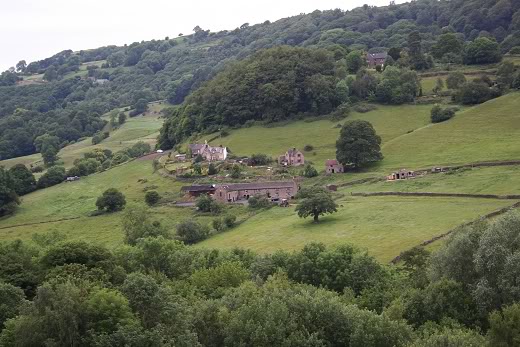
Left: The A6 from the incline. Right: A farmstead on the hillside.
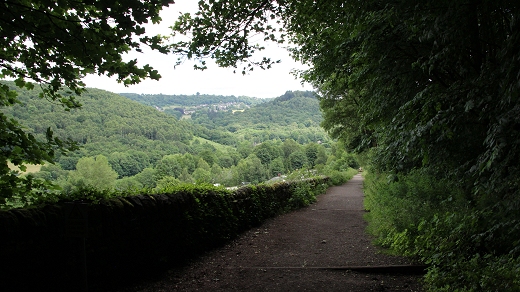
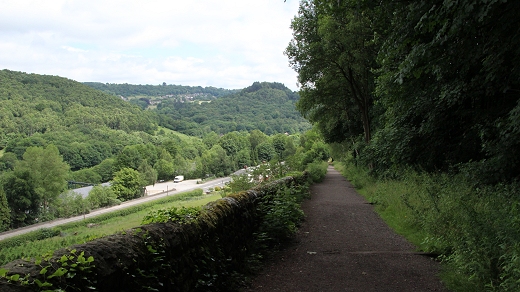
Both: View over the A--- down to Cromford Goods. (24th June 2017)
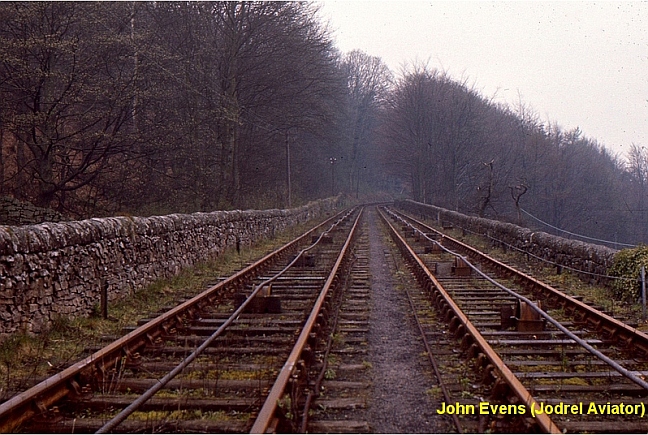
On the straight climb from Sheep Pasture Bottom, towards the curve leading to the half-way point.
(April 1967 photo by John Evens)
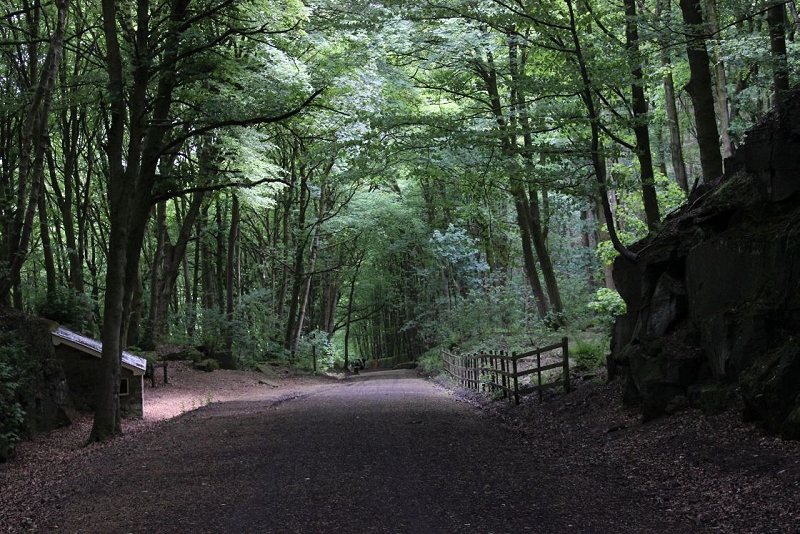
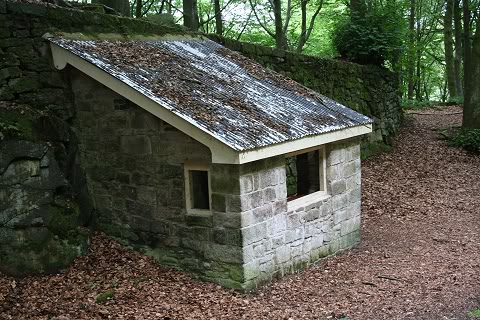
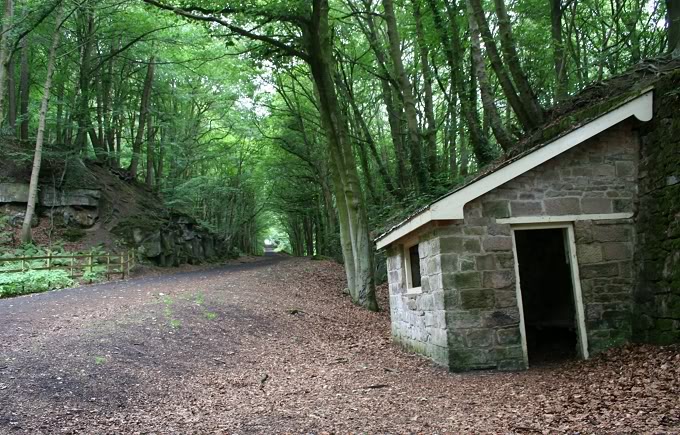
Half-Way point. This shed is the only remaining building from the mid-way Engine house that stood in the space behind the fence on the right.
(16th May 2016).
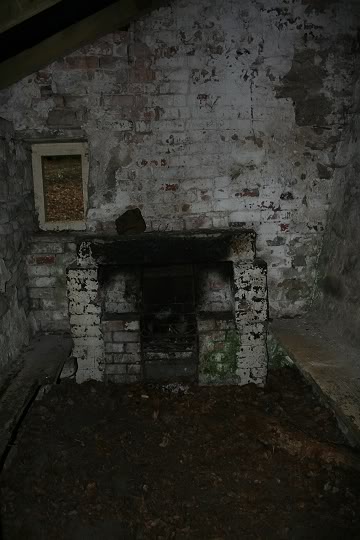
The interior of the Hut. (Flash). August 2011.

The setting certainly emphasizes the gradient. Originally there had been two incline engine houses on this section and an
engine house stood at this halfway point. This shed may have been part of that working.
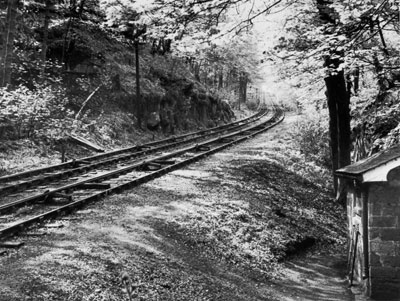
At the same spot as above. (Author Unknown).
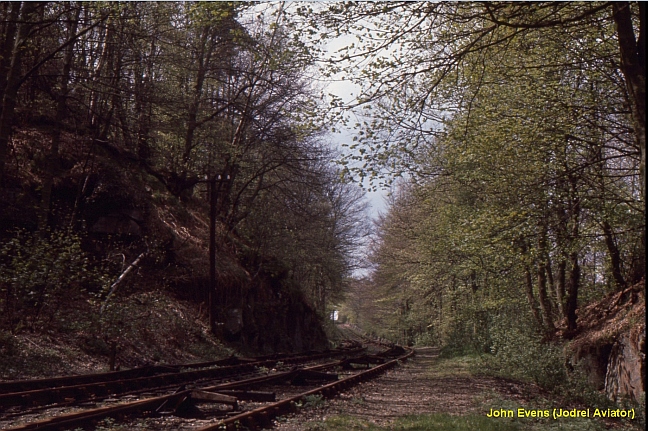
Same area by John Evens in 1967.

This had been on the level for attaching and detaching wagons from the wire but the gradient has been raised when the Engine House
was taken out of service.
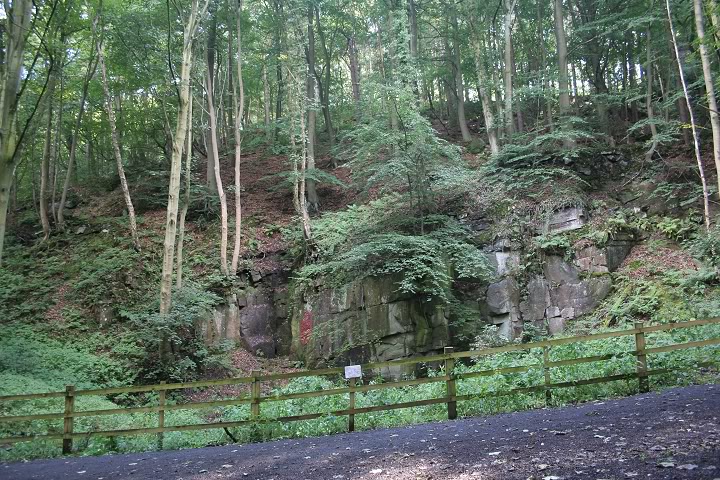
Site of the intermediate Engine House between High Peak Goods and Sheep Pasture Summit (1837-1857) Aug. 2011.
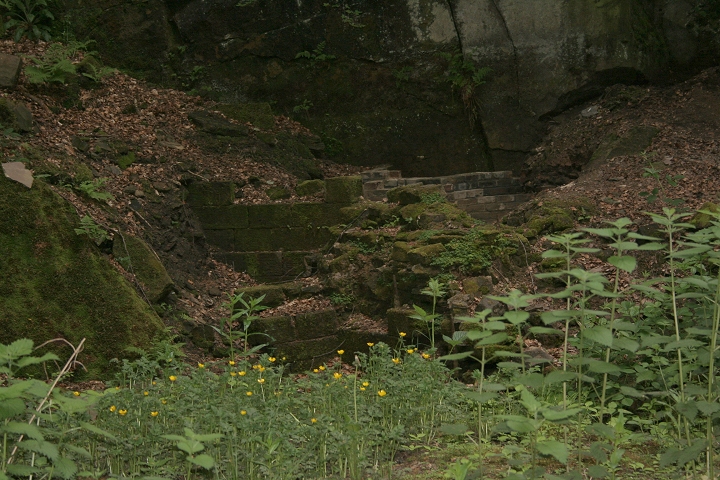
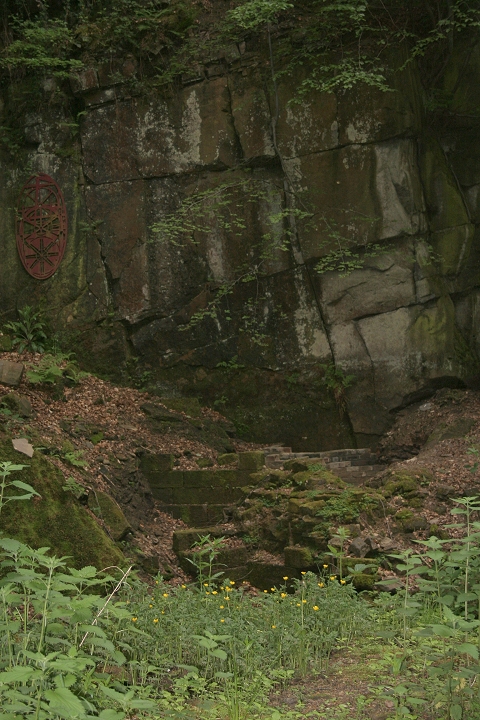
The red bricks to the bottom center are the remains of the intermediate engine house.
(May 2012)
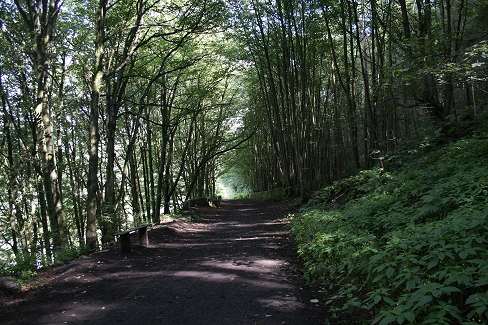
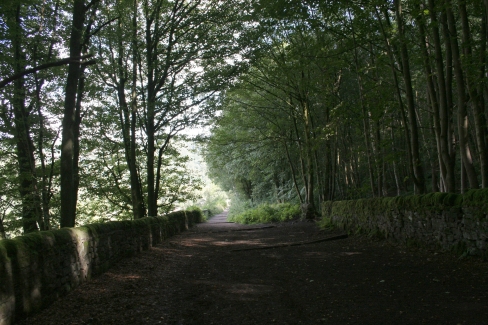
Above: Just beyond the half way point. Left: Looking down the incline. Right: Looking down the incline. ( August 2011).
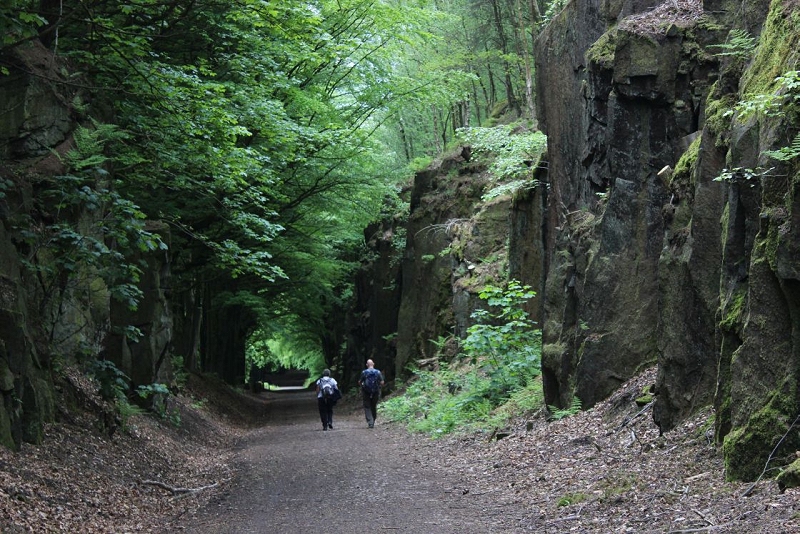
Down through the deepest part of the cutting towards half-way point. (16th May 2016).
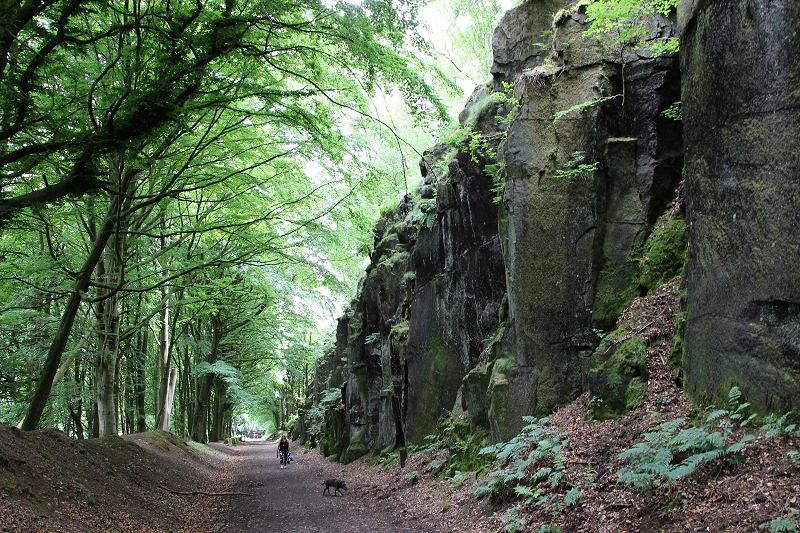
Ditto. 24th June 2017).
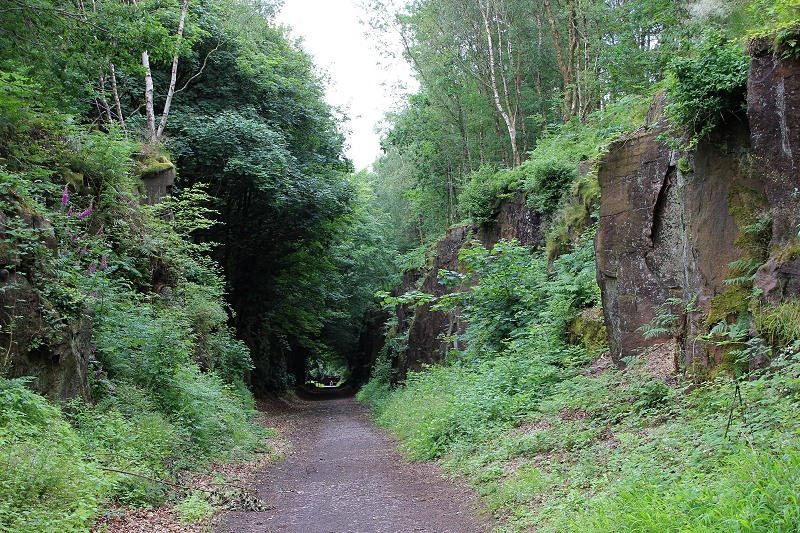
Ditto. 24th June 2017).
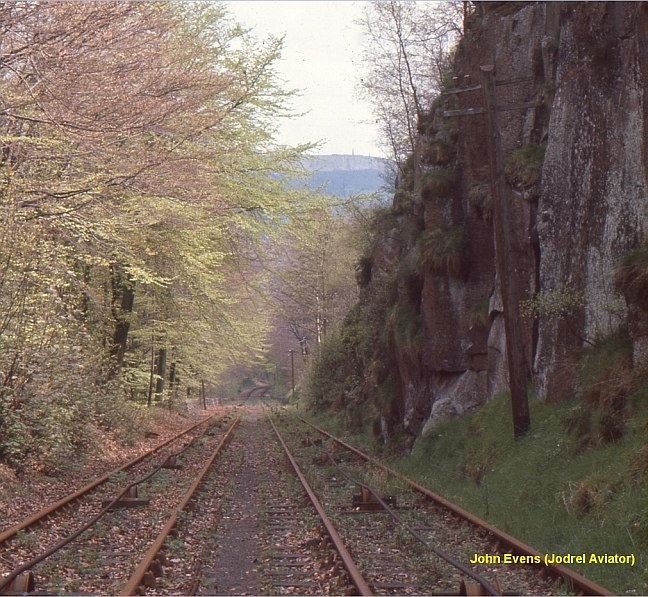
Nearthe same spot. in 1967. (John Evens).
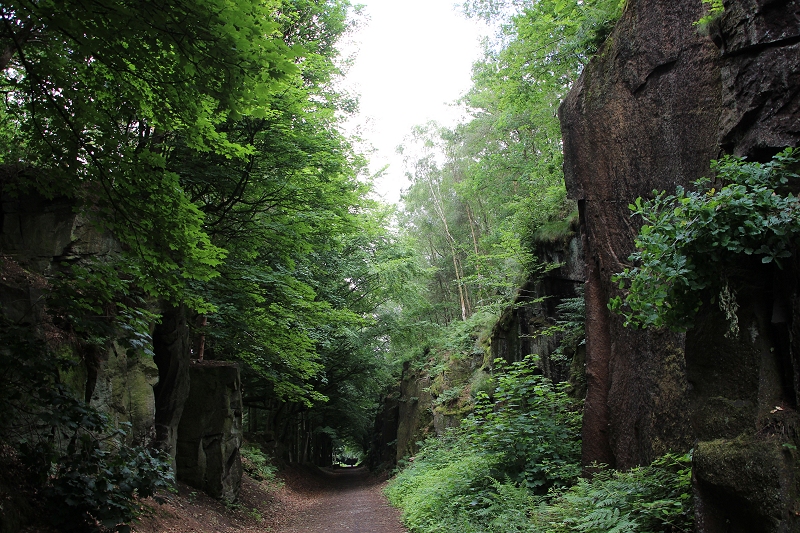
Ditto. 24th June 2017).
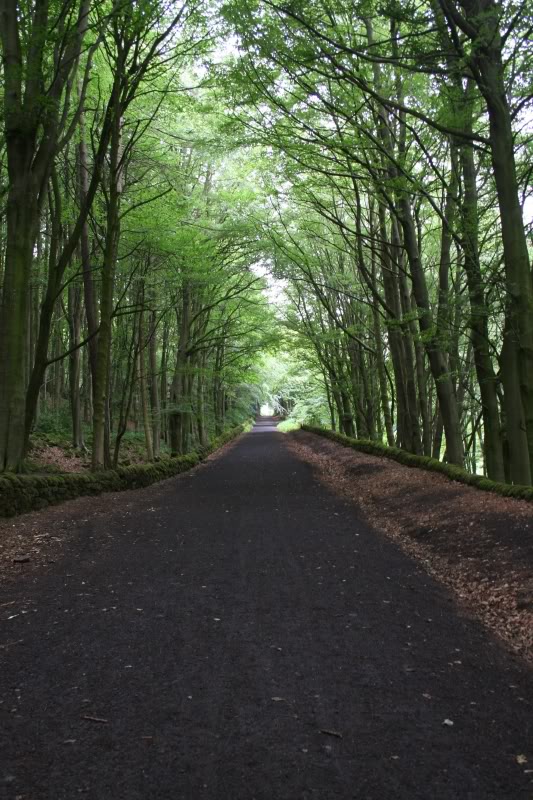
Halfway on the incline
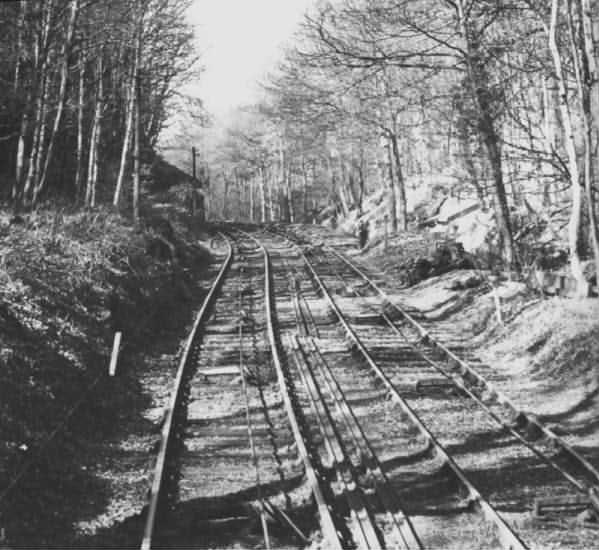
From approximately the same spot. Where a secondary Engine house stood.
(Cromford & High Peak Official Web Site)
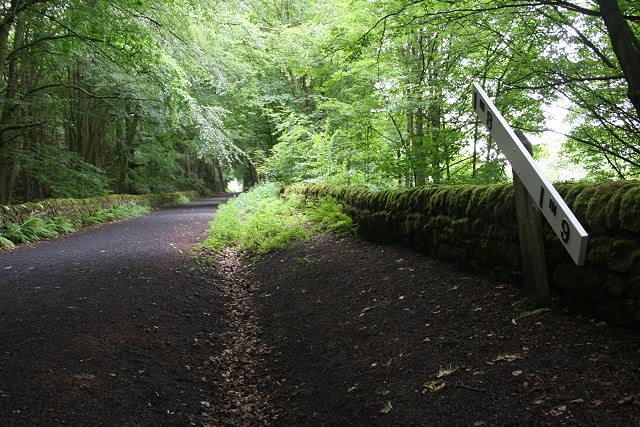

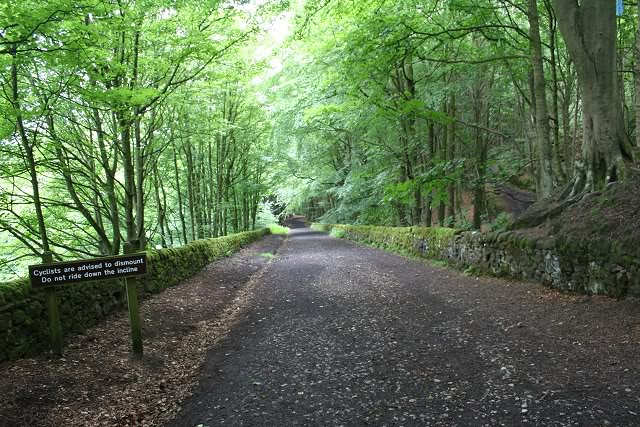
From the same spot above, looking down the gradient
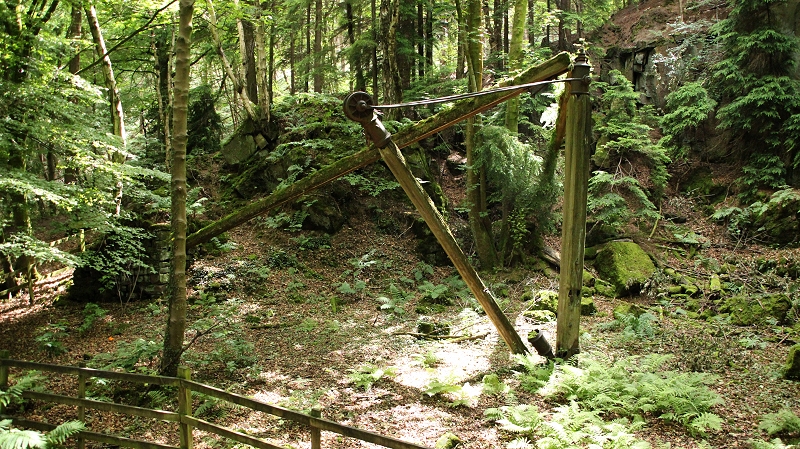
Remains of a wooden Crane on what would have been a small working quarry by the side of the line. (24th June 2017)
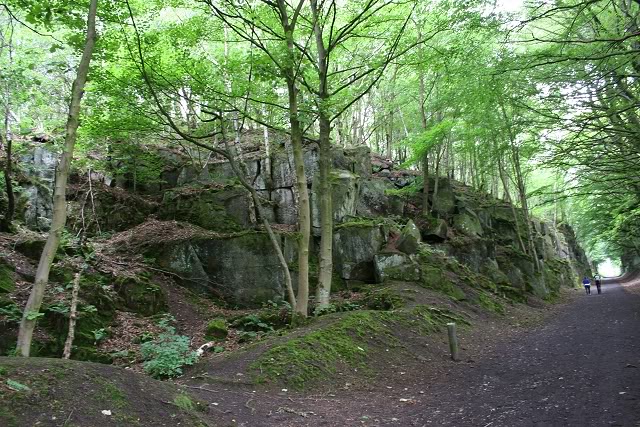
Interesting rock formation.
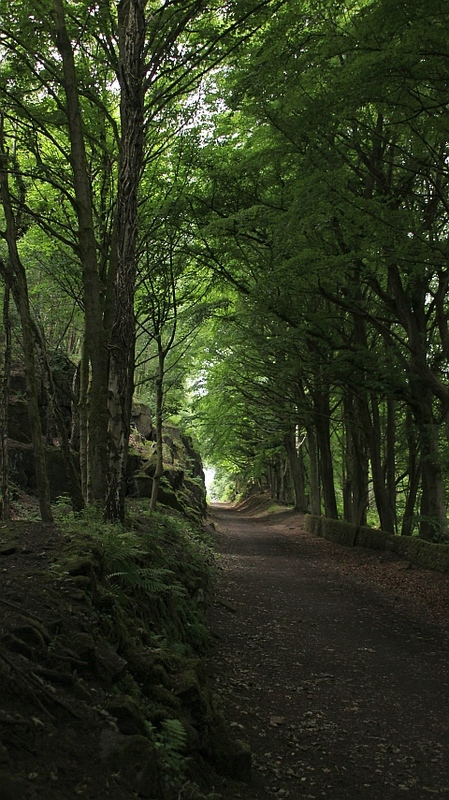
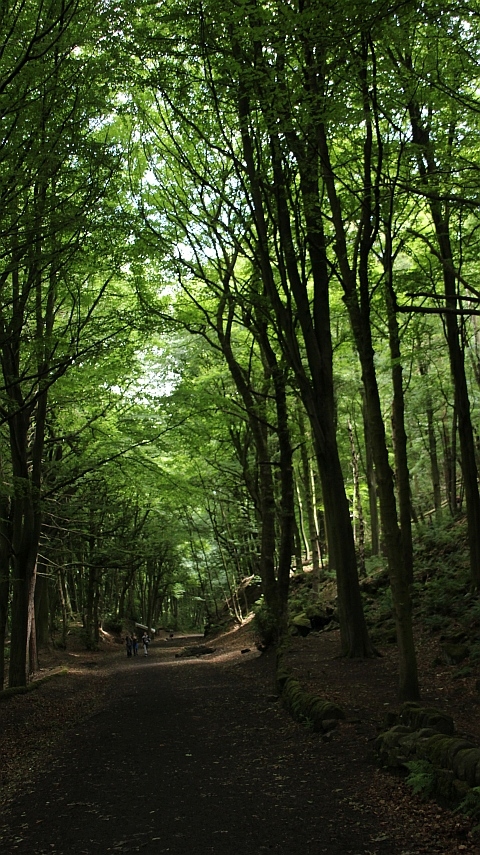
Left: Looking up the incline. Right: Down towards Cromford Goods. (21st. June 2017).
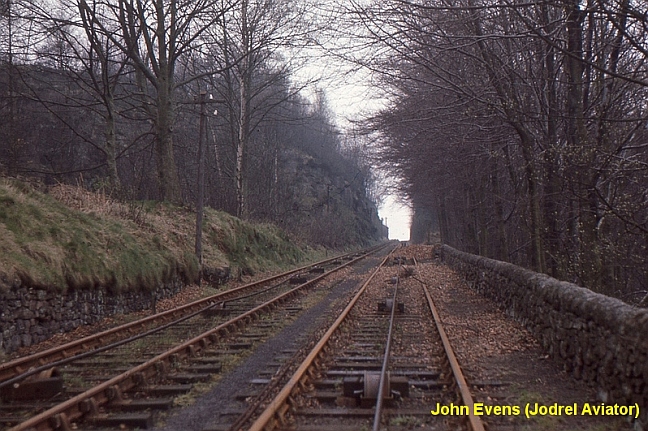
Just over the half way mark with the summit just in view.
(April 1967 photo by John Evens)
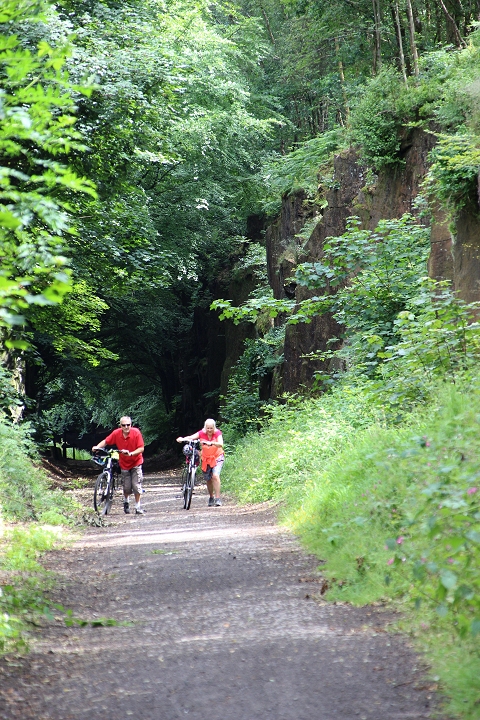
Nearing Sheep Pasture summit (24th June 2017).
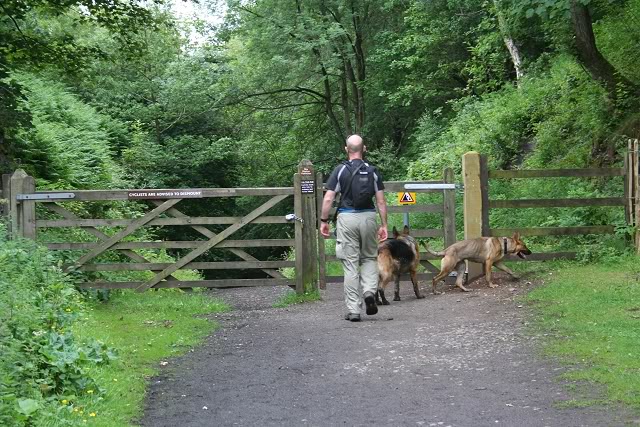
The summit is gated to stop cyclists from taking a run onto the steep gradient. It is also a timly warning
to walkers to take care on the slippery surface when it has been raining.
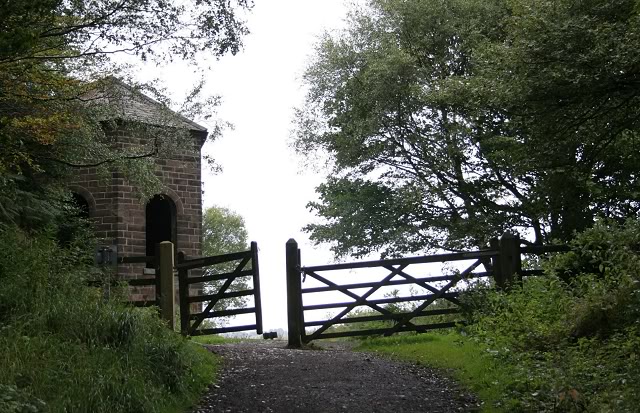
Sheep Pasture Engine House at the summit of the incline (Aug. 2011)
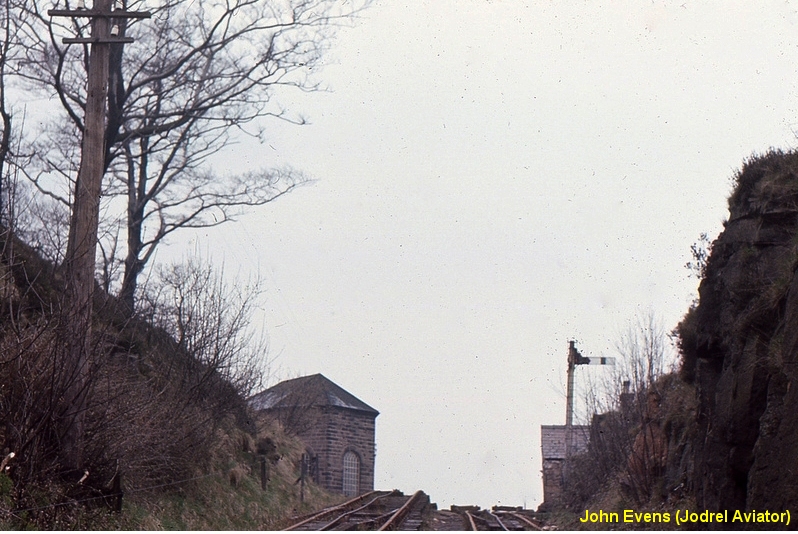
In 1967 (John Evens).


Where the rope wheel was fixed to the outside of the building with the wire guide run. A more complete set-up is seen at Middleton Top
The steam engine was replaced by electric power during the latter years.
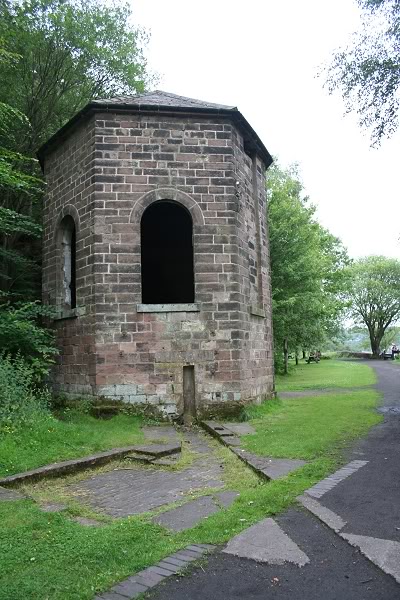
Remains of the Wheel Pit
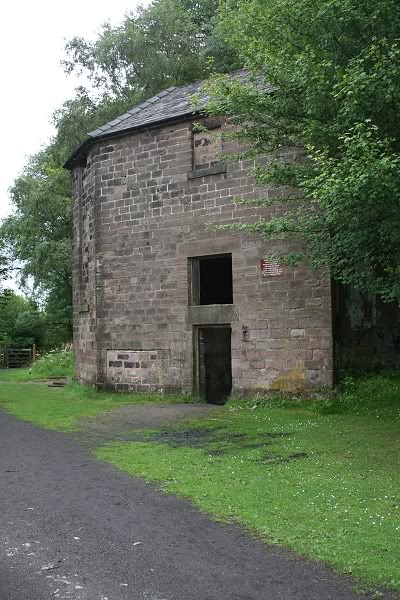
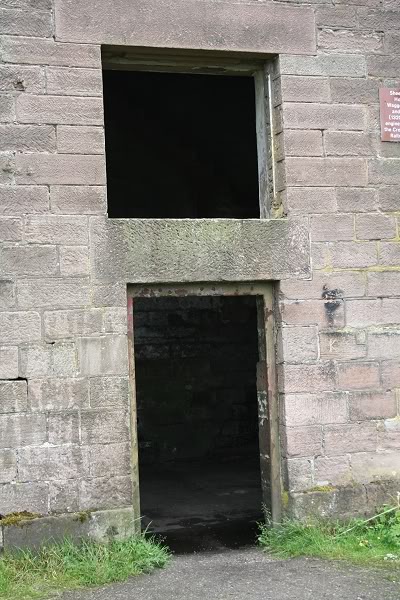
The building is an empty shell but is safe to enter and look around.
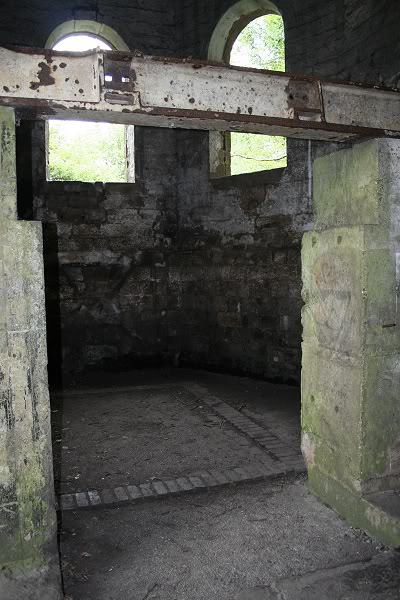
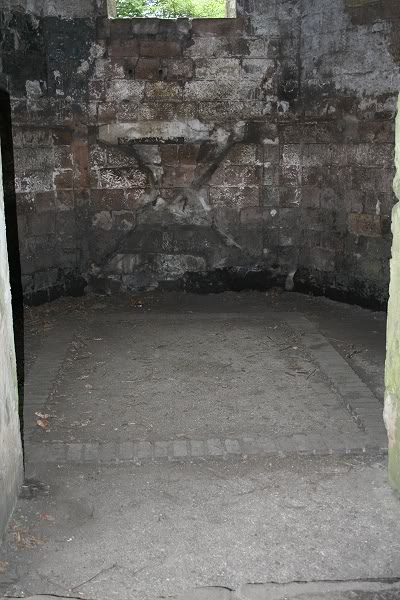
The base where the engine stood and and an over beam are still in place but the hole where the rope wheel went outside has been filled in.
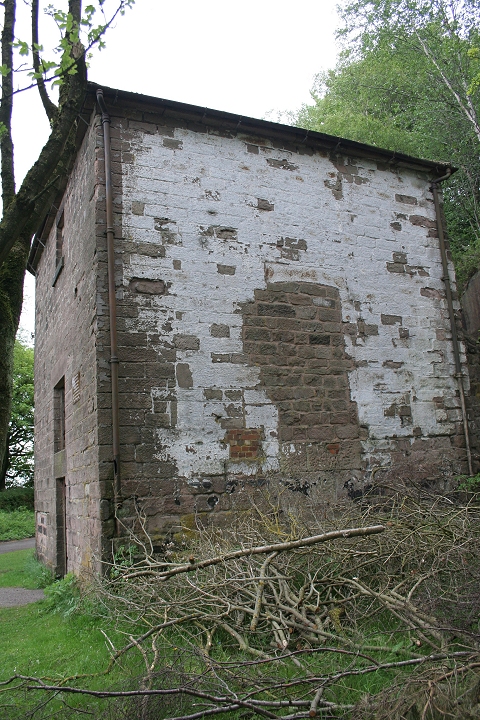
The Engine House had a lean-to building at the east end, with a slanting roof.
Probably a store. The building has been demolished but can be seen in numerous
old photographs.
New Photos from 16th May 2016.
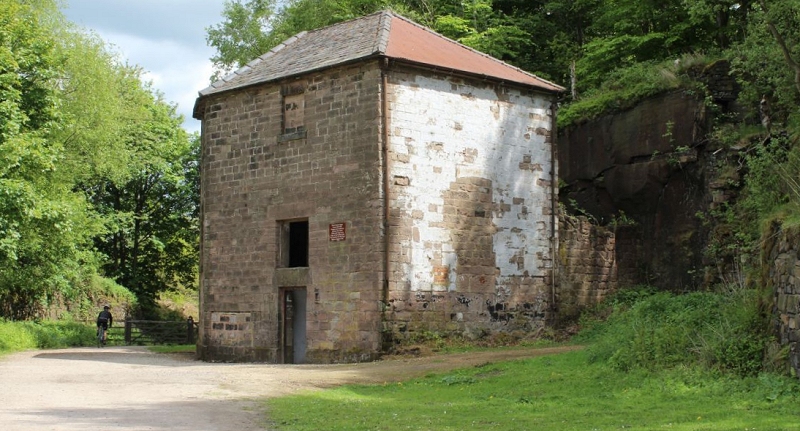
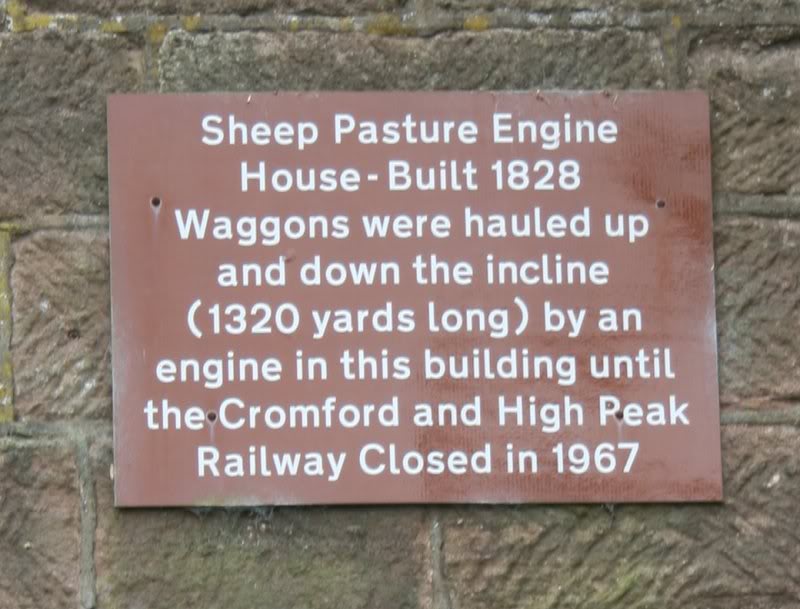
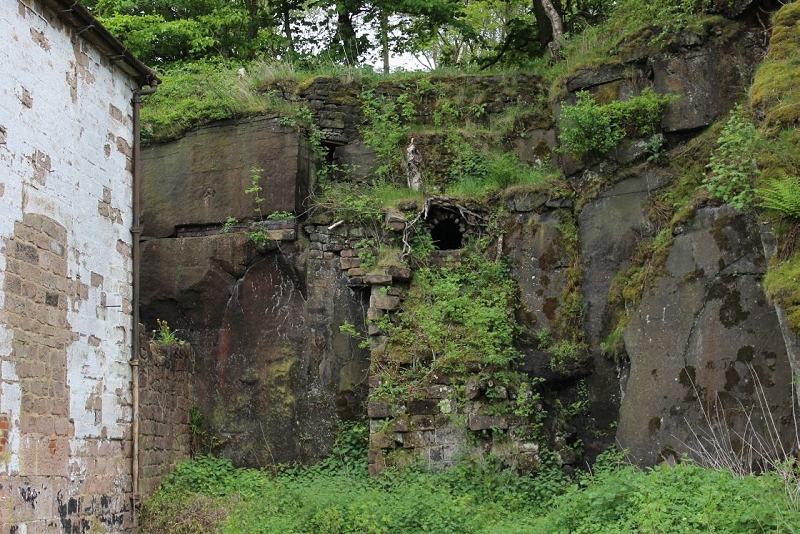
The hole in the side of the cliff was the route the smoke from the Steam Engine took. The actual chimney was built up on the cliff top just out of
sight in this photo.
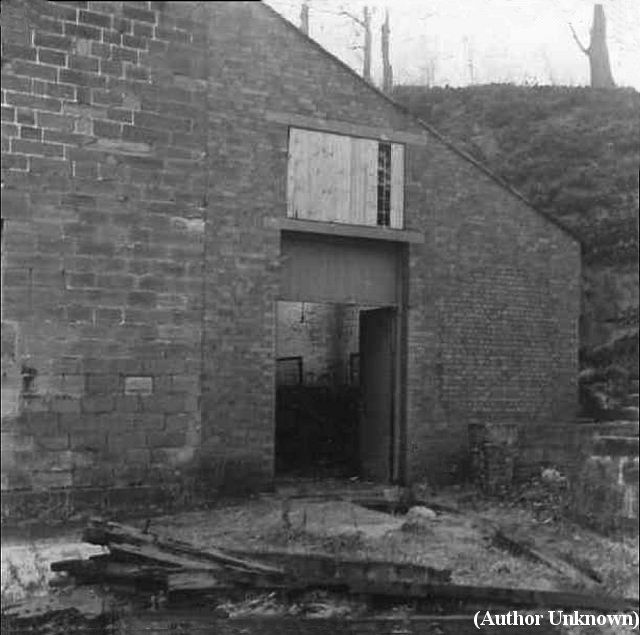
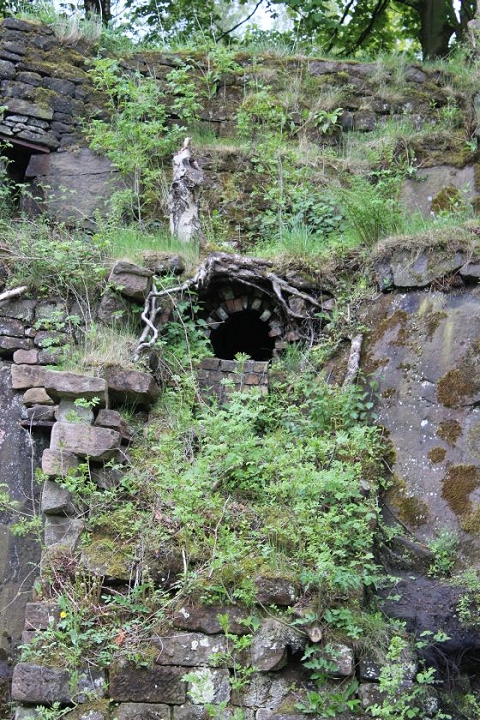
Left: Sheep Pasture Boiler House entrance. According to the model photo below the boiler must have been removed once the electric drive had been added and the hole in the wall bricked over!
Right: A closer view of the Ex chimney tunnel leading to the actual chimney above.
================================================================
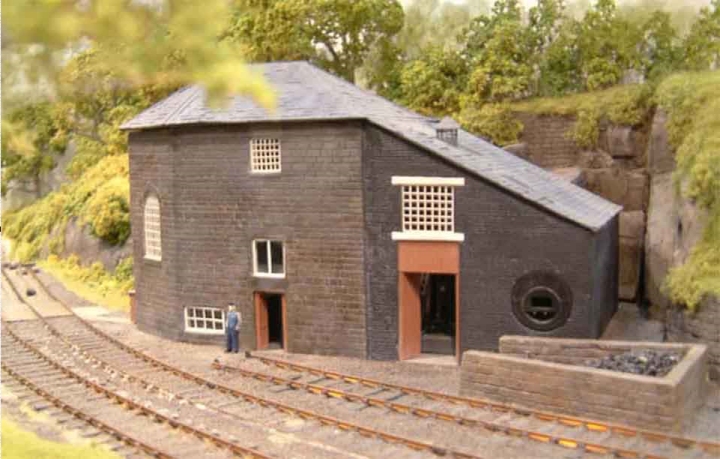
July 2012. I have since discovered this very fine model railway of Sheep Pasture. I have not come across any photos showing that the
'Lean-to' building was actually the Boiler House and this photo shows that the boiler was on view just as you see the two
at Middleton Top. Check this very fine model railway out a the link below. To Do...
Sheep Pasture Model Railway
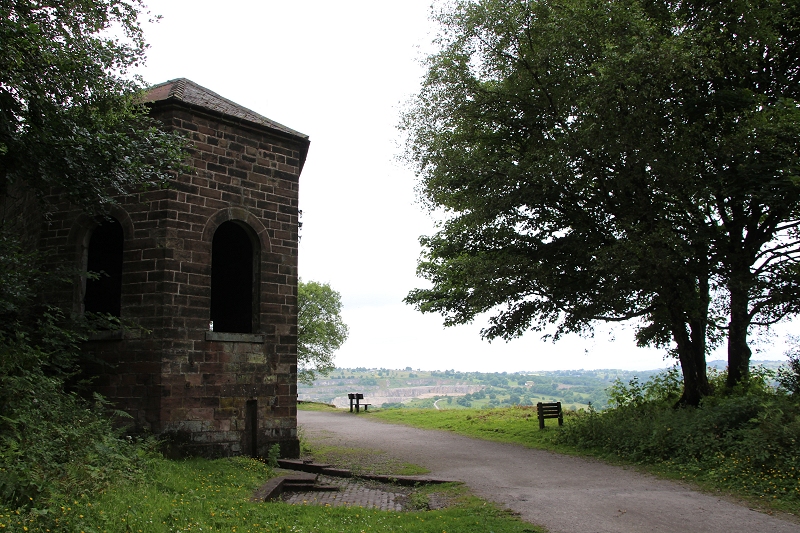
Sheep Pasture Engine House at summit. The track bed curves towards Black Rocks. (24th June 2017).
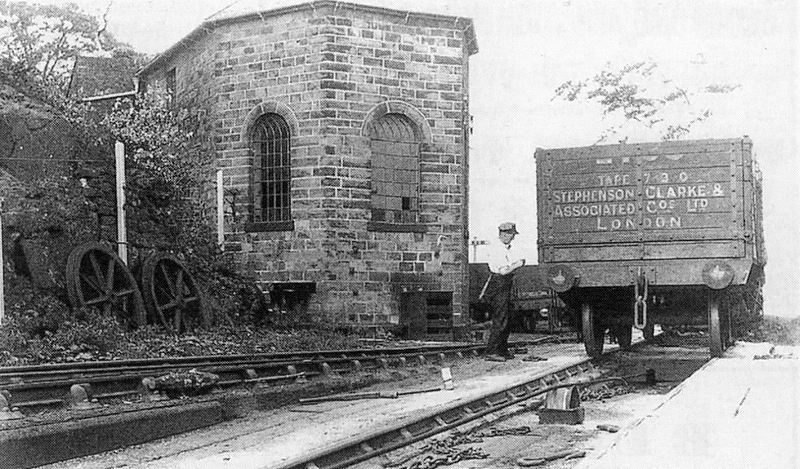
Virtually the same spot. The Shunter is preparing wagons for ascending the incline. N.B. The wire wheel at the bottom of of the engine house
is covered for safety. You can see where the wire comes out just below the wagon. The two large wheels to the left are interesting. They are spares
and may possibly have came from the engine houses at Bunsell or Hopton. Stephenson Clarke became Stephenson Clarke Shipping Ltd. and is the
oldest shipping company. (Author Unknown).
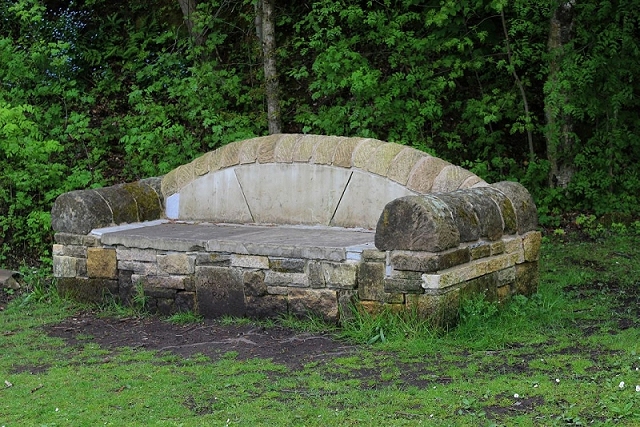
A new piece of furniture has been added at Sheep Pasture. 16th May 2016.

From the summit the line is fairly level as far as Middleton Bottom. This is where the sidings were, along with
the locomotive water tank etc.
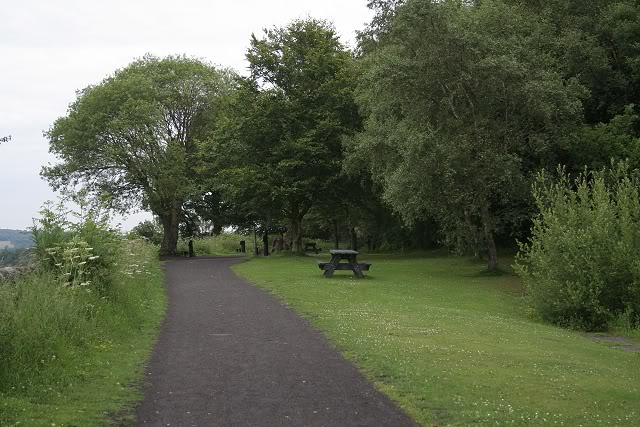
Opposite view. This is now a picnic area with fine views over the valley
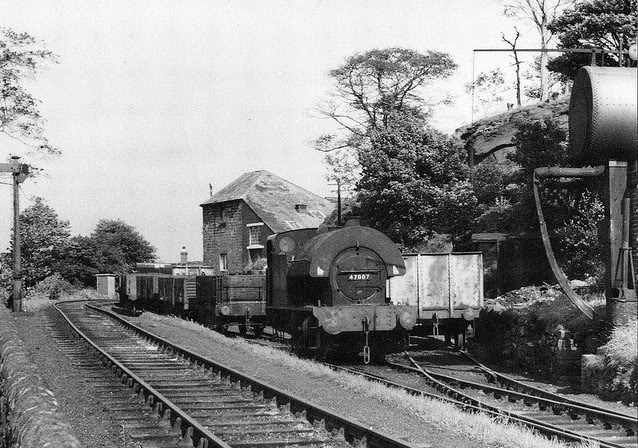
The same spot in the 1960's. Quite a picturesque spot even in railway days. It is interesting how much the railway
designers could pack into quite a tight spot. (By Duckwalk (Flickr).
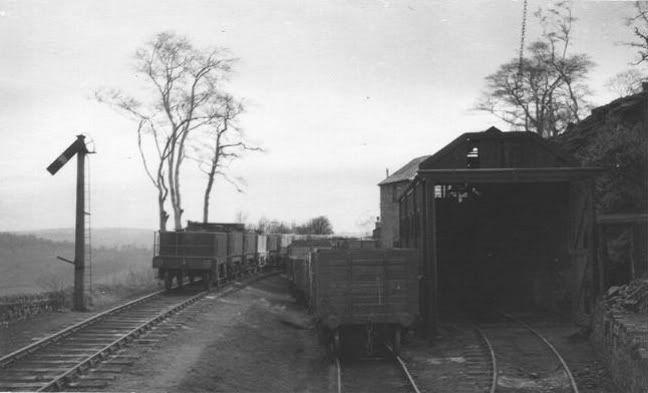
1949. Sheep Pasture Loco Depot (D. J. Norton)

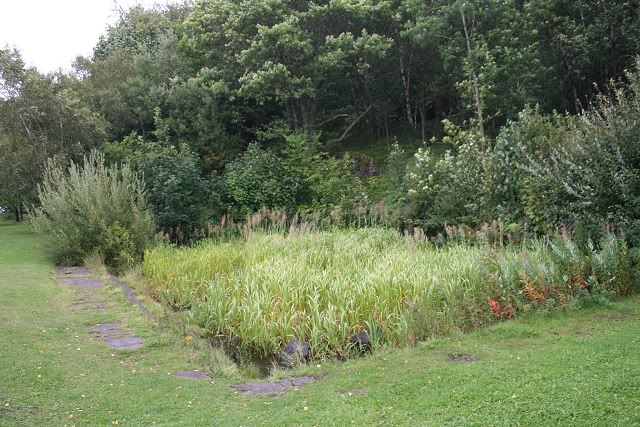
urce, approximately where the Water Tank stood, at north end of Sheep Pasture (Aug. 2011)
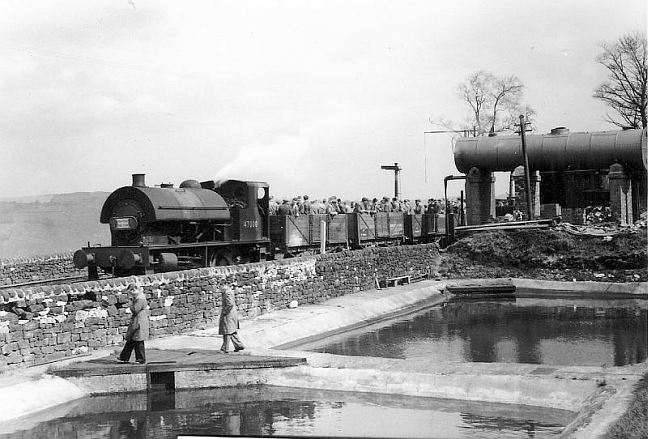
47000 with it's wagon load of enthusiasts, at Sheep Pasture. From the present photo above you would not expect the reservouir
site to have looked like this. (25th Apri 1953. J. W. Sutherland).
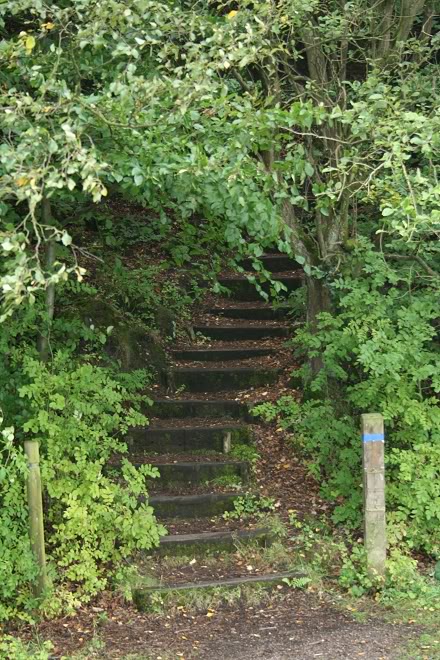
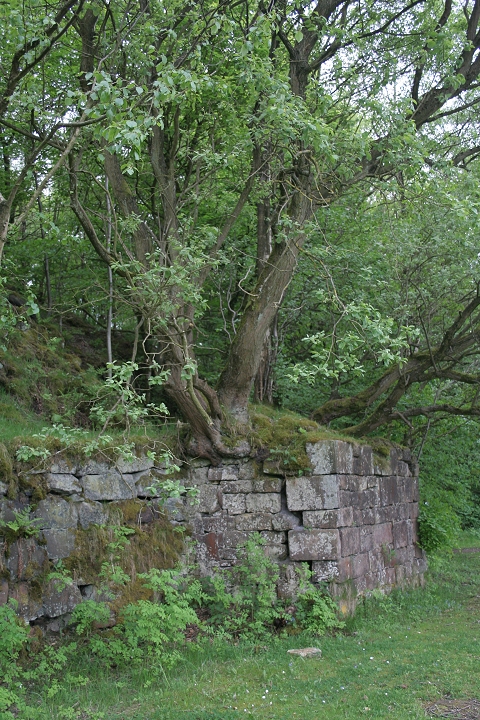
Left: Original C&HPR steps at Sheep Pasture (Aug. 2011) The steps lad up to the where the Engine House chiney still stands.
Right: Remans of the base where the Loco Water Tank stood.
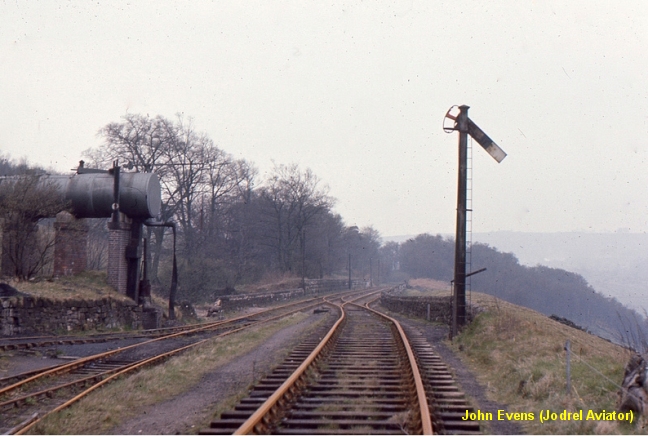
Sheep Pasture. Looking towards Black Rocks. April 1967. Soon after closure. The reservoir was behind the wall just ahead of
the water tank.
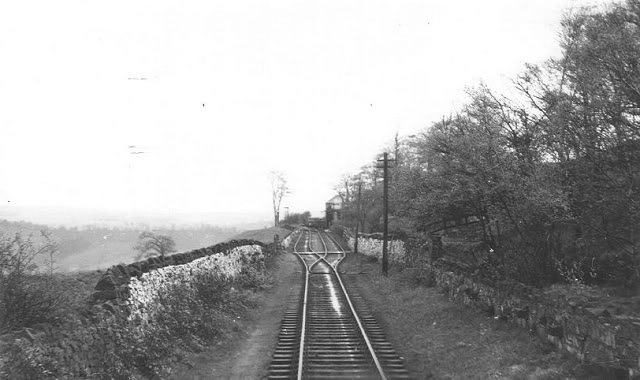
1949. Approaching Sheep Pasture Top. Reverse view from above. The signal box is interesting in that it is not seen in
the photo above.(D. J. Norton)
There are fine views across the Cromford valley....
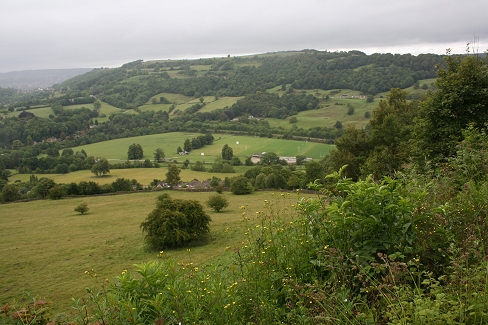
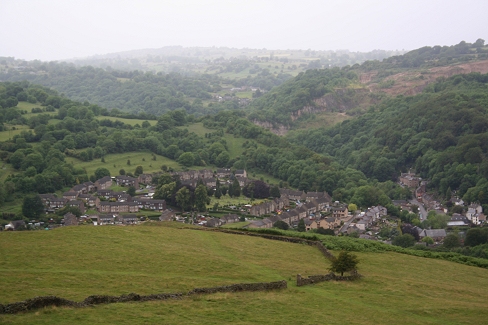
Left: The Derby-Matlock branch running north to south below the hills. Right: Cromford
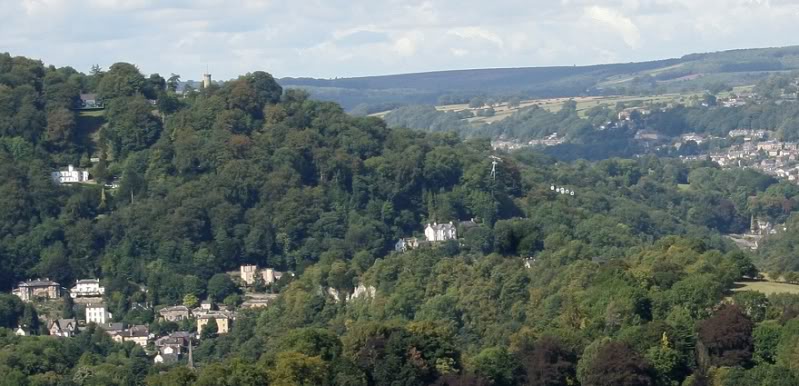
Cropped image from above. The cable cars (Two Passing each other). Seen at center right. The tower, above the tree line, marks the terminus at the
Lead Mine Museum. The building, top left, in the trees, is the mine restaurant & bar, with a grand view over the valley to the Sheep Pasture area.
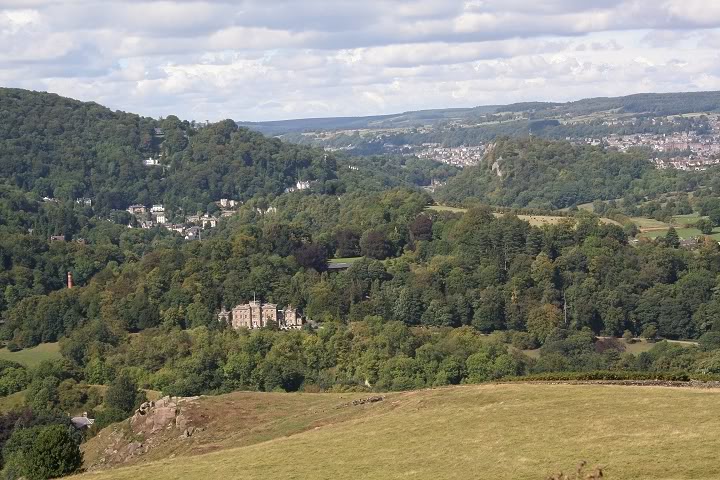
Willersley Castle, now a hotel, was built in 1792 for Sir Richard Arkwright, known as the father of the industrial age. Also in the scene
you can just make out the Cable Cars climbing up from Matlock Bath to the Lead Mine Museum at the Heights Of Abraham. Top left.
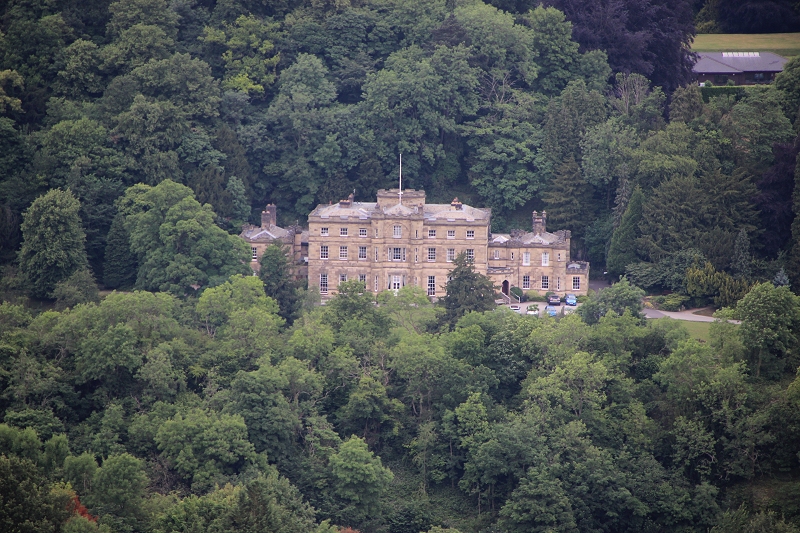
Sir Richard Arkwright's home through the 200mm zoom lens. (24th June 2017)
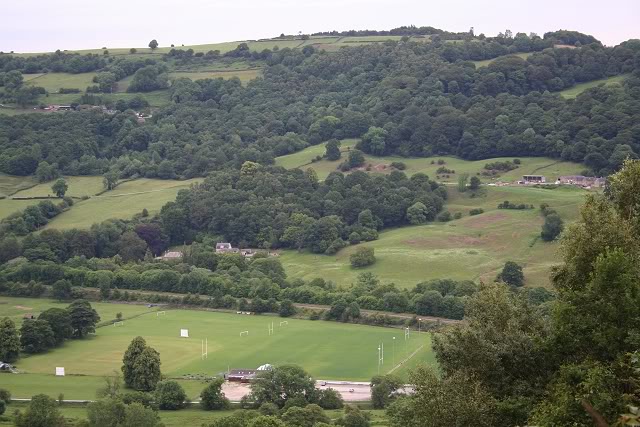
St. Pancreas to Derby and Manchester but is now a single line branch off the Derby-Sheffield mainline at Ambergate.
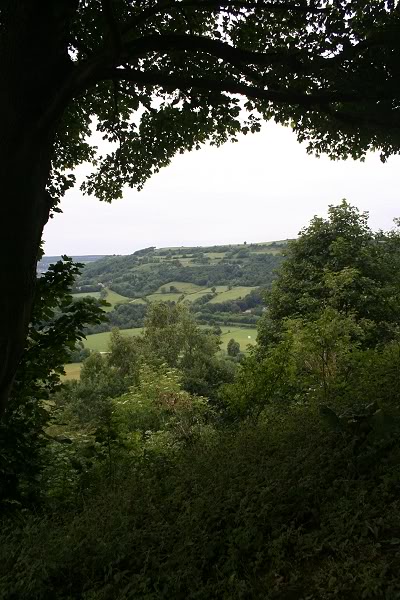
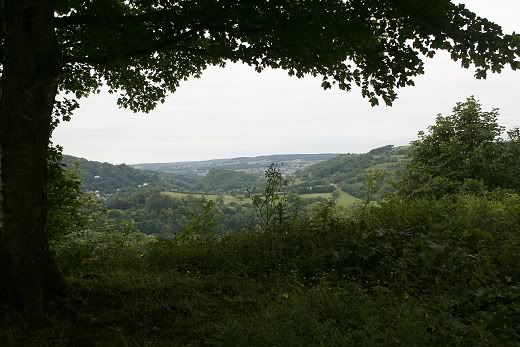
Looking towards Cromford From the site where the Sheep Pasture control signal stood, with Matlock in the far distance
=================================================
(To SHEEP PASTURE TO MIDDLETON BOTTOM
My Thanks To......
John Neave for his kind permission to use a number of his 1960's photographs when the railway was still in operation. Check out John's ''Going Loco'', which includes a C&HPR history. At....
http://goingloco.neave.com/
Mark Norton for the use of 1940's photos by his late father Dennis J. Norton.
http://www.photobydjnorton.com/CHPR_Menu.html#Links
John Evens for the fantastic colour photos taken in April 1967 just prior to the line closing. John's photos can be viewed on Flickr under JodrelAviator.
Reading: "The Cromford & High Peak Railway" by John Marshall. Published by Martin Bairstow. Printed by The Amedeus Press 2011.
Other Railway Walks....
The Dundee & Newtyle Railway The first passenger railway in Scotland built in 1831, which had three inclines operated by stationary steam engines. The main source of income was from
the numerous stone quarries in the area and local farming produce. Passenger numbers were always sparse.
The inclines were abandoned in the mid 1800's by new deviations that allowed through locomotive running.
The line also included the Dundee Law (Hill) tunnel built at 300ft above the City. Both the north & south portals of the tunnel are buried below modern housing
schemes. Passenger services ended in 1955 and the line closed completely in the mid 60's.
Unlike the C&HPR none of the Engine houses were preserved. The inclines can still be followed but sections have been back-filled or ploughed over
This web site tries to cover as much as possible.
Boddam To Ellon Branchline Built by the GNSR in the latter part of the 20th century. The passenger service only lasted until 1934 but goods remained up to total closure in 1949.
The GNSR built a large Golf course and Hotel at Cruden Bay, with an electric tramway between the station and hotel. All that remains today is the Golf course.
Other web pages....
Kittybrewster Memories. Kittybrewster Loco Depot, Aberdeen.
Tivoli Memories The Tivoli Theatre, Aberdeen.
Hosted by www.theatreorgans.com